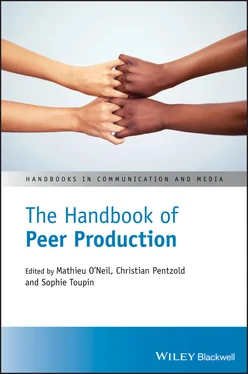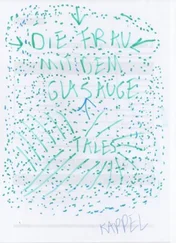The Handbook of Peer Production is divided in six parts. Part Iis the shortest, being made of this chapter, in which we (editors Mathieu O’Neil, Sophie Toupin, and Christian Pentzold) set the scene. Part II(chapters 2 to 6) outlines the key Concepts which help to make sense of peer production: Vasilis Kostakis revisits a famous Michel Bauwens article to define the core elements, or Grammar of Peer Production projects and ecosystems. Benjamin J. Birkinbine defines the Political Economy of Peer Production , Christian Pentzold outlines the Social Norms and Rules of Peer Production , and Michael Stevenson discusses the Cultures of Peer Production . We conclude this part with this volume’s sole reprint, Yochai Benkler and Helen Nissenbaum’s 2006 article on Commons‐Based Peer Production and Virtue .
Part III(Chapters 7 to 11) defines the necessary Conditions for peer production to exist: George Dafermos defines the Prophets and Advocates of Peer Production and Margie Borschke explores Virtue, Efficiency, and the Sharing Economy . Next, Mélanie Dulong de Rosnay analyzes Openness and Licensing , and Sebastian Spaeth and Sven Niederhöfer focus on User Motivations in Peer Production . We conclude this part with an analysis of the relationship between project governance and scope, Governing for Growth in Scope: Cultivating a Dynamic Understanding of How Peer Production Collectives Evolve by Rebecca Karp, Amisha Miller, and Siobhán O’Mahony.
Part IV(Chapters 12 to 20) presents Cases of peer production practice, including Free and Open Source Software by Stéphane Couture, Wikipedia and Wikis by Jutta Haider and Olof Sundin, Collective Cartography: Drones, Countermapping, and Technological Power by Adam Fish, and Peer Learning by Panayotis Antoniadis and Alekos Pantazis. Morgan Meyer analyses Biohacking , Yana Boeva and Peter Troxler present Makers , and Pablo Velasco Gonzáles and Nate Tkacz critically assess Blockchain, or Peer Production Without Guarantees . Finally, Gwen Shaffer retraces the history of Community Wireless Networks and Nicholas Anastasopoulos of Commoning the Urban .
Part V(Chapters 21 to 27) maps out areas where peer production practices and projects enter into Conflict with internal and external structures of power. Mathieu O’Neil and Sébastien Broca address Peer Production and Social Change , and Stefania Milan Peer Production and Collective Action . Sophie Toupin discusses Feminist Peer Production and Maitrayee Deka Postcolonial Peer Production . Francesca Musiani assesses Gaps in Peer Design whilst Kat Braybrooke and Adrian Smith interrogate Makerspaces and Peer Production: Spaces of Possibility, Tension, Post‐Automation, or Liberation? We conclude this section with Alex Pazaitis and Wolfgang Drechsler’s Peer Production and State Theory: Envisioning a Cooperative Partner State .
Having perused this list of authors and chapters, we trust our readers will agree with us that the Handbook of Peer Production has succeeded in accounting for the diversity of peer production histories, endeavors, theories, and contradictions. But when dealing with this topic, which is centered around do‐it‐yourself values such as individual empowerment, cooperation amongst equals, and engagement and participation, this is not enough. It would be impossible to write a comprehensive volume about peer production, and not contribute in some way. We must go further, by connecting peer production to a progressive social agenda.
Part VI(Chapters 28 to 30) therefore defines Conversions , elements that will advance peer production. In Making a Case for Peer Production we present interviews with practitioners Peter Bloom ( Rhizomatica ), Mariam Mecky ( HarassMap ), Ory Okolloh ( Ushahidi ), Abraham Taherivand ( Wikimedia ), and Stefano Zacchiroli ( Debian ). In What’s Next? Peer Production Studies? , we (editors Mathieu O’Neil, Sophie Toupin, and Christian Pentzold) outline promising avenues for new research into the contribution of peer production to productive efficiency and to social change. We also reflect on whether the Handbook fits into a field of “peer production studies,” which necessarily involves a brief discussion of the political economy of academic publishing. Our final chapter, Be Your Own Peer! Principles and Policies for the Commons situates the participatory and democratic qualities of peer production in the wider context of current political, health, and ecological crises, and outlines strategic principles and policy proposals aiming to increase sustainability and fairness.
Creating the first Handbook of Peer Production has been a privilege. We hope it is of use.
1 Aaltonen, A., & Lanzara, G. F. (2015). Building governance capability in online social production: Insights from Wikipedia. Organization Studies, 36(12), 1649–1673.
2 Alderman, J. (2001). Sonic boom: Napster, mp3, and the new pioneers of music. New York, NY: Basic Books.
3 Arazy, O., Lifshitz‐Assaf, H., & Balila, A. (2019). Neither a bazaar nor a cathedral: The interplay between structure and agency in Wikipedia’s role system. Journal of the Association for Information Science and Technology, 70(1), 3–15.
4 Auray, N. (2005). Le sens du juste dans un noyau d’experts: Debian et le puritanisme civique. In B. Conein, F. Massit‐Folléa, & S. Proulx (Eds), Internet, une utopie limitée: Nouvelles régulations, nouvelles solidarités (pp. 71–94). Laval, QC: Presses de l’Université Laval.
5 Baran, P. (1964). On distributed communication. Santa Monica, CA: Rand.
6 Barbrook, R., & Cameron, A. (1996). The Californian ideology. Science as Culture, 6(1), 44–72.
7 Barron, A. (2013). Free software production as critical social practice. Economy and Society, 42(4), 597–625.
8 Bastani, A. (2018). Fully automated luxury communism: A manifesto. New York, NY: Verso.
9 Bauwens, M., Kostakis, V., & Pazaitis, A. (2019). Peer to peer: The commons manifesto. London: University of Westminster Press.
10 Benjamin, R. (2019). Race after technology: Abolitionist tools for the new Jim Code. Cambridge: Polity.
11 Benkler, Y. (2002). Coase’s penguin, or, Linux and “The nature of the firm.” The Yale Law Journal, 112(3), 369–446.
12 Benkler, Y. (2006). The wealth of networks: How social production transforms markets and freedom. New Haven, CT: Yale University Press.
13 Birkinbine, B. (2020). Incorporating the digital commons. Corporate involvement in free and open source software. London: University of Westminster Press.
14 Bollier, D., & Helfrich, S. (2019). Free, fair, and alive: The insurgent power of the commons. Gabriola Island, BC: New Society.
15 Boltanski, L., Chiapello, E., & Elliott, G. (trans.) (2005). The new spirit of capitalism. London: Verso.
16 Bonaccorsi, A., & Rossi, C. (2004). Altruistic individuals, selfish firms? The structure of motivation in open source software. First Monday 9 (1). https://doi.org/10.5210/fm.v9i1.1113
17 Bowker, G., Baker, K., Millerand, F., & Ribes, D. (2010). Toward information infrastructure studies: Ways of knowing in a networked environment. In J. Hunsinger et al. (Eds.), International handbook of internet research (pp. 97–117). Dordrecht: Springer.
18 Broca, S. (2013). Utopie du logiciel libre: du bricolage informatique à la réinvention sociale. Lyon: Le passager clandestin.
19 Burrell, J. (2012). Invisible users: Youth in the Internet cafés of urban Ghana (Acting with technology). Cambridge, MA: MIT Press.
Читать дальше


![О Генри - Справочник Гименея [The Handbook of Hymen]](/books/407356/o-genri-spravochnik-gimeneya-the-handbook-of-hymen-thumb.webp)









